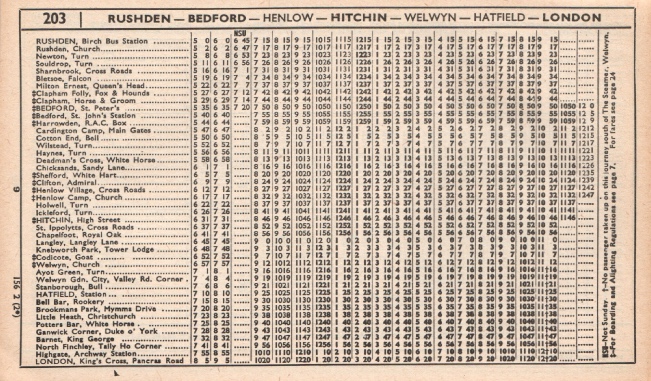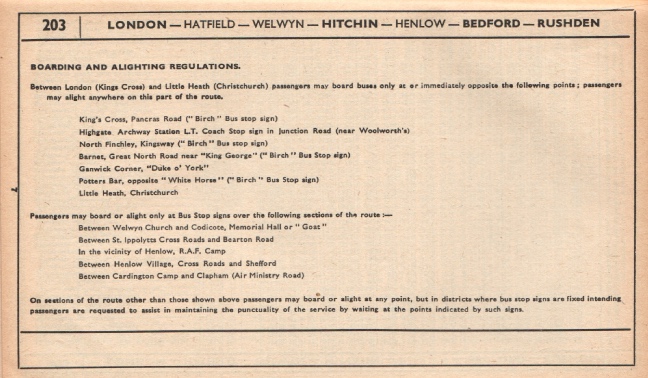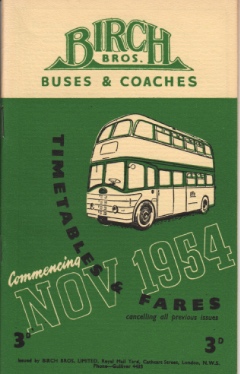|
|
|
|
|
|
|
|
|
| BIRCH BROS LTD |
A fondly remembered operator on the long 203 service from London
through Hitchin and Bedford to Rushden |
|
|
|
|
| Please
note - this is a site of historical record and does not contain current
service information |
|
|
|
|
Birch Bros can trace their transport antecedents back to
1810 when
William Birch left Plymouth in Devon to seek his fortune in
London. The proud story of the past and future of the family
business appeared inside the Birch timetable for many years. His
daughter-in-law Elizabeth, assisted by her two sons, progressed
from horse cabs to horse buses in 1847, running from Pimlico to Mansion
House. Subsequent expansion through following generations
of the family saw them working on a succession of London routes and
becoming members of the then current horse omnibus associations (eg the
Camden Town Omnibus Association and the Atlas and Waterloo Omnibus
Association). The associations were disbanded by 1909.
|
| Thus
the Birch family have been in the transport
business since long before the days of the motor bus. Motor
vehicles joined the fleet in 1919 (an earlier short lived experiment
with motors in 1907 having been unsuccessful) and operated See Britain
tours. Birch were also active in the London taxi business.
The firm re-entered the London bus business in 1925, notably on
536 Highgate to Brockley Rise. With an
eye to the future and the impending changes that were to come in the
early 1930s with the establishment of the London Passenger Transport
Board (LPTB) in 1933, they pioneered a country route from London
northwards to
Bedford in 1928. This was extended to Rushden and Kettering (at a
lesser frequency) by 1930. Originally referred to as routes B and
K - later combined as route BK - in
1942 this was re-numbered as Birch route 203. They bought out
Beaumont Coaches who competed over part of the route to Bedford in
November 1932 (Beaumont had previously bought out another earlier
competitor Constants Coaches in 1929). From London as far as Hitchin
the Birch route competed with the similar
Green Line routes to Hitchin and Welwyn so frequency, minimum fare and
picking
up and setting down restrictions were imposed by LPTB as far as Little
Heath (just north of Potters Bar). |
|
 |
|
|
|
|
|
During
the latter years of the 1930s the country operations were
expanded through the acquisition of a number of smaller operators in
the counties of Hertford and Bedford. Firstly in January
1938, Birch Brothers acquired Wright ("Pirton Belle") of Pirton,
together with his daily route from Hitchin to Pirton. The latter became
part of route 209. Wright had also run between Pirton and Luton
and Pirton and Letchworth. Birch attempted to link these into a
Luton - Letchworth service but was unsuccessful following refusal of a
licence by the Traffic Commissioner. Two months later in
March the firm acquired Fisher ("Sunbeam") of Gravenhurst, including
routes from Campton to Luton (becoming part of 212) and Gravenhurst to
Hitchin (part of 225). Then came Twydell of Shillington, which
Birch absorbed into revised routes 209 and 225 from Shillington to
Hitchin. The following month Hancock of Horne Hill, Whitwell ("Whitwell
Bus Company") was taken over along with routes from Luton to Whitwell,
and from Hitchin to Whitwell (later 206 and 204). Also in April
Birch acquired Cardings of Kempston ("Swallow Bus Service") and added
the Harrold-Bedford route (211).
Now
in May of the same year 1938, Birch turned their attention to the
Rushden area, and three local operators Abbot & Sons, G. Robinson,
and G. H. Scroxton were taken over together with their tours and
excursion licences from Rushden. Then finally for 1938, in July Jenkins
(trading as Perseverance) of Bury Road, Shillington was purchased and
three more routes Meppershall to Luton; Shillington to Hitchin; and
Henlow Camp to Luton acquired (part of 212). A new modern depot
had been built in High Street North, Rushden during 1937, but the
increase in vehicles required to operate the additional country
services meant that a further depot was needed and this was built in
London Road, Henlow Camp, near the RAF base, and opened in December
1938 (somewhat more modest premises though than the splendid art-deco
building at Rushden). The introduction of national service in 1938 and
the two RAF camps at Cardington and Henlow rapidly created extra
traffic, especially at weekends, on the main 203 route. Thus ended a
momentous year of expansion for
Birch Bros.
War
came and by 1940, double deckers were running on the trunk London to
Rushden route, and on the country routes as well, particularly Henlow -
Luton (212). A further acquisition in June 1944 was Enterprise of
Kimpton with their Welwyn - Kimpton - Luton route (the Birch 205
service). Post war there were concerns that passenger transport
businesses might be nationalised by the Labour government then in power
- a natural concern from a family business who had already seen their
original operations in London lost to the LPTB in 1933. These
concerns may have been a contributory reason for splitting the coach
business from the bus business into a separate company.
Always proud of their independence, the feared nationalisation of 1949
never came to pass. See how proudly the cover of the 1953
timetable shown below is repeatedly printed with the words "non
combine".
|
|
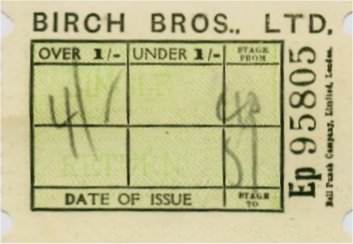 |
|
|
|
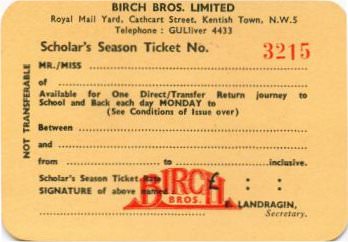 |
|
|
|
|
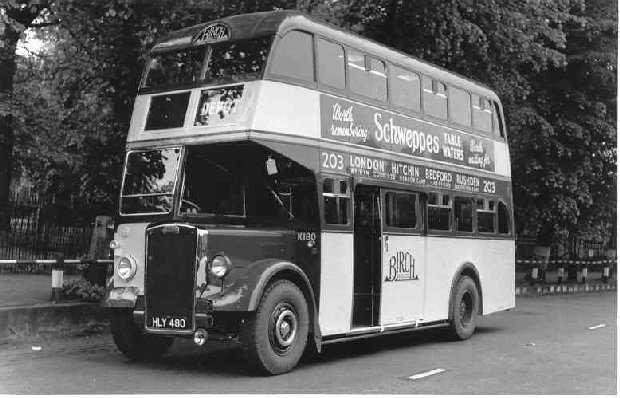
|
|
 |
|
On the left,
HLY
480, fleet number K180, one of the post-war Leyland PD1's, sign-written
with the main London - Rushden 203 route very much in mind
|
|
|
|
|
Sunbeam timetable 1934 (Fisher of
Gravenhurst)
|
|
|
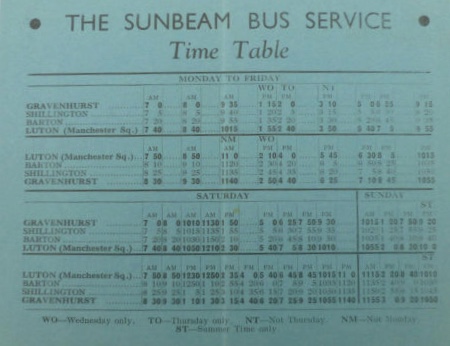 |
|
The principal route
was always the 203 from London Kings Cross through Welwyn, Hitchin and
Bedford to Rushden in Northamptonshire. In pre-war days it was
extended further to Wellingborough and Kettering a couple of times a
day. Probably to the chagrin of the Birch management, the route
missed the potential traffic in post-war years from the growth of the
new towns at Stevenage and Welwyn Garden City. The latter was
tantalisingly skirted just to the west and whilst attempts were made to
reroute the service through Stevenage, these were refused by London
Transport, who controlled the licensing and regulation of services in
the then "London Special Area".
In 1955 the 205 and
206 Luton - Welwyn services were increased in
frequency and extended to reach Welwyn Garden City. On Saturday
afternoons a 30 minute frequency was operated.
|
|
|
|
Timetable 17th June 1956
for the short lived 215 route to Stevenage |
|
|
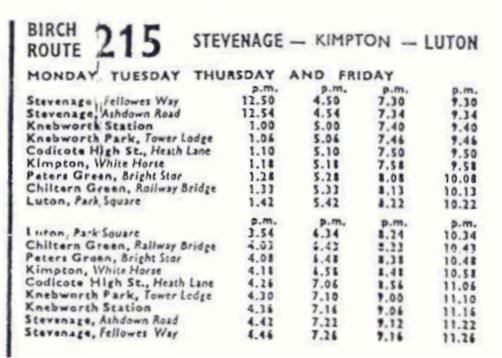 |
|
Stevenage was
eventually reached - not by the 203 - but by a new route 215 from Luton
from 17th June 1956. However the 215 timetable seems to have been
designed primarily to take people to Luton. But with fuel rationing
following the Suez crisis at this time, cut backs on this and other
country area routes soon followed.
The 203 operated hourly in the 1950s with double deck buses and
the
"Marlborough" class epitomised the Birch Bros operation as I remember
it. These 53 seat double-deckers had eye-catching rounded
Willowbrook
bodies on a mix of Leyland and Guy chassis, and unusually had a luggage
pen at the front of the upper deck. Some of the other buses in
the
fleet carried bodies that Birch had built themselves in their workshop
and depot situated at Royal Mail Yard, Cathcart Street, Kentish Town,
London NW5. The name reflected their mail carrying business
for the
Post Office back in horse-drawn stagecoach days!
|
| |
|
|
|
LXV212,
fleet number 212, one of the Marlborough class (Guy Arab / Willowbrook
53 seater)
resplendent in the firm's cream livery with lime green lining
|
|
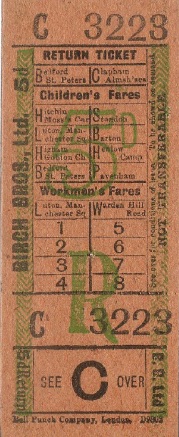 |
|
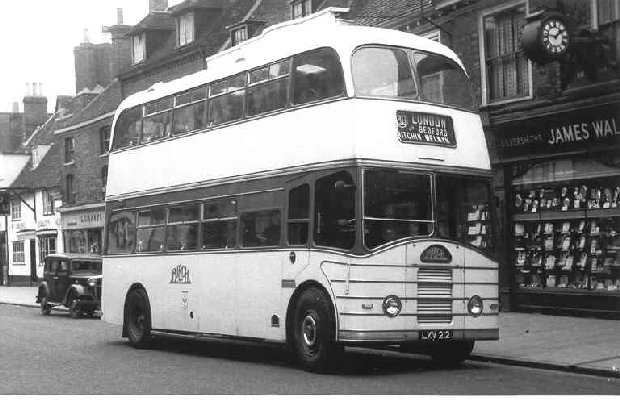
|
|
|
|
|
|
|
As years went by the
company, in common with other transport
providers, carried fewer and fewer passengers. An innovation in
October 1959 was to reroute part of the main 203 service onto the newly
opened M1 motorway, making a faster journey between Bedford and
London. This was designated as route 203M and progressively the
number of through journeys to London on the original route 203 was
reduced, with most of the runs southwards terminating at Welwyn (the
hourly frequency was maintained northwards from there to Bedford and
Rushden).
The last double deckers
ran in September 1967 when the last three
Leyland Titans were withdrawn from Henlow. Previously on the 26th
December 1963, after over 130 years running, the last Birch Brothers
taxicab had been withdrawn. Given the continuing downturn in bus
passenger numbers it was decided to abandon the stage carriage services
altogether, with the country routes discontinued on the 14th October
1968. The depot at Henlow Camp closed then as well. During
the last few years the depot inspector here had use of the unique Birch
/ Standard diesel taxi. The last arrival at Henlow on the 203 in the
early hours of the 15th October was driven by Charlie Taylor who had
driven the first bus out of the depot when it had opened in December
1938! Finally on the 14th September 1969, the last two routes 203
/ 203M were passed to United Counties together with twelve vehicles.
Rushden garage was sold. The bus operations of Birch Bros were no more,
although the coaches ran for a few more years from Kentish Town.
On 1st February 1971 the business and the coaches were sold to the
George Ewer Group, and the Birch name faded from the public transport
scene for ever.
|
|
|
|
|
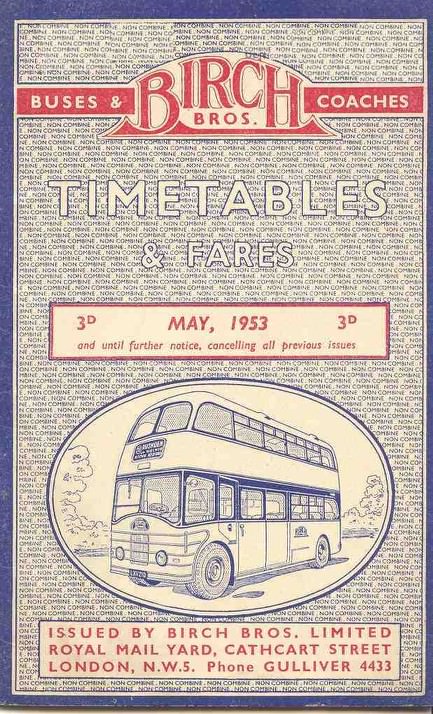
|
|
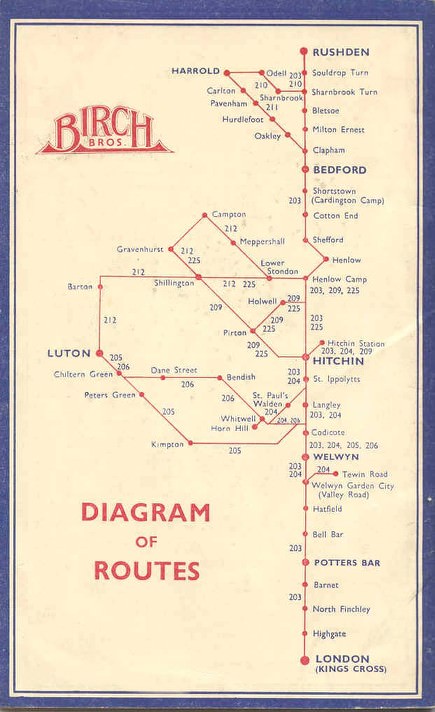
|
|
|
|
Timetable pages from the November 1954
booklet
|
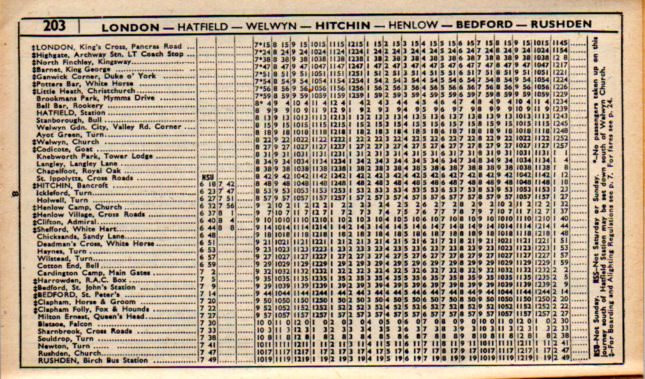 |
|
|
|
|
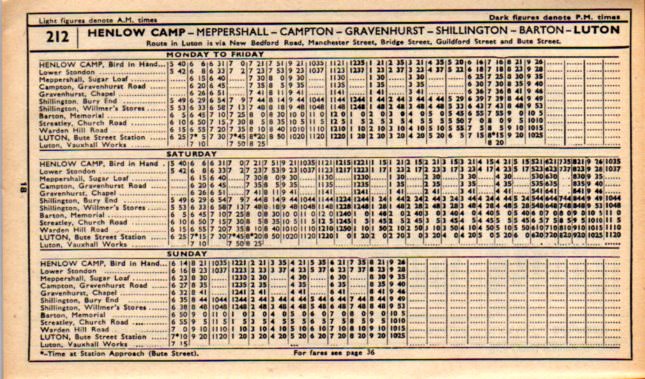 |
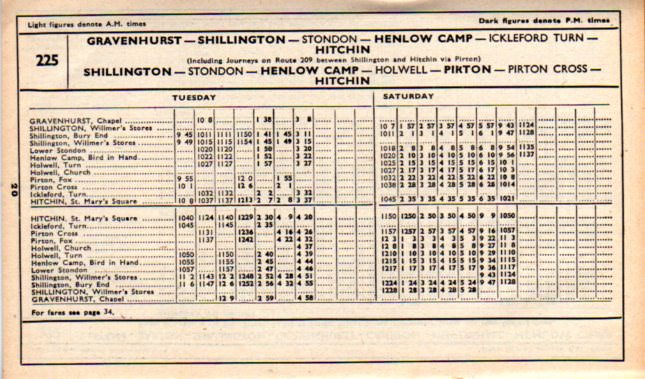 |
|
List of Birch Bros bus routes at
their
maximum in mid-1956
|
| |
|
| 203 |
London - Welwyn - Hitchin - Bedford -
Rushden |
| 203M |
London - M1 Motorway - Bedford -
Rushden |
| 204 |
Hitchin - Whitwell - Welwyn |
| 205 |
Welwyn - Kimpton - Luton |
| 206 |
Welwyn - Whitwell - Luton |
| 209 |
Henlow Camp - Holwell - Hitchin |
| 210 |
Harrold - Odell - Sharnbrook - Rushden |
| 211 |
Harrold - Carlton - Pavenham - Bedford |
| 212 |
Henlow Camp - Gravenhurst -
Shillington -
Luton |
| 213 |
Gravenhurst - Campton - Shefford -
Bedford (Saturdays
only) |
| 215 |
Luton - Kimpton - Knebworth -
Stevenage (Mondays,
Tuesdays, Thursdays and Fridays only) |
| 225 |
Hitchin - Henlow - Shillington /
Gravenhurst (Tuesdays
and Saturdays only) |
| |
|
|
Route 210 ran mainly positioning
journeys
from Rushden to work the 211, whilst both the 213 and 215 were
short-lived routes.
|
There
were three depots at Kentish Town (London NW5), Rushden and
Henlow
|
|
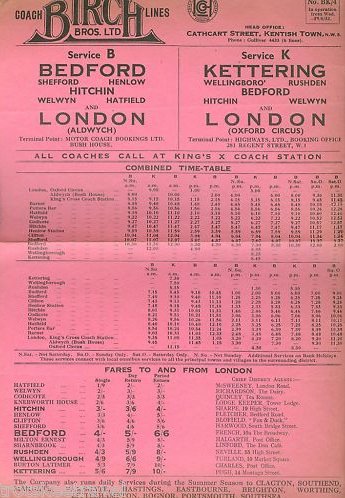
|
|
|
|
Pre-war
northern extension of route:
On the left a
Birch timetable from June 1932 showing route B to Bedford and route K
to Kettering. Note that route K to Rushden (2 journeys) and to
Kettering via Wellingborough (1 journey) started from Oxford
Circus before picking up at Kings Cross coach station. Similarly
route B started from Aldwych. Later the routes were combined as
BK and eventually became the famous 203 of later years. |
|
|
|
|
Clare Staines remembers:
My grandfather, Eric Landragin, was
the accountant for Birch Bros from
1930 to 1943; and then from 1945 to 1971 he was assistant director when
he retired aged 72. I have one of the calendar tiles from 1953. I think
he got the ‘Keys to London’ for his contribution to keeping transport
in London going through WW2 and my mother said he went up to London
every day regardless of the bombing.
|
|
|
Valerie
Woodcraft remembers:
My
father Les
Sales was depot inspector at Henlow Camp until the end of Birch
operations from there in October 1968. He had been a Birch
conductor before that and I used to travel to school on the Birch bus.
We knew Charlie Taylor who drove the last service.
Les's
notes include these
route updates. Further consolidation of the Harrold - Bedford route was
achieved in 1951 when the business of Mrs Jarvis of Carlton was
acquired, giving Birch all of the timings on this route. A very
short-lived route was attempted in 1959, numbered 215 and lasting only
a year, from Hitchin to Stevenage via Codicote.
The
tours and excursions from
Henlow, Hitchin Letchworth and Baldock were an important part of the
work from Henlow Camp depot right until the end. Destinations
included Great Yarmouth, Stratford on Avon, Margate, Southend and many
others.
|
|
| the 1953 calendar and advert tile |
|
|
|
1955 calendar and advert tile |
|
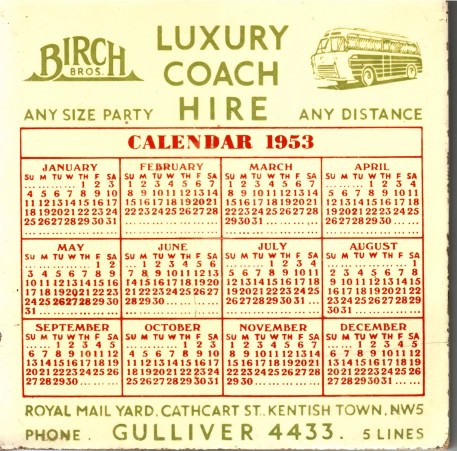
|
|
|
|
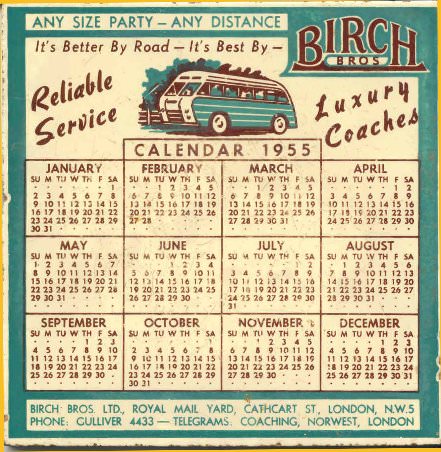 |
|
|
|
|
|
|
|
|
|
|
|
|
|
|
|
|
|
|
|
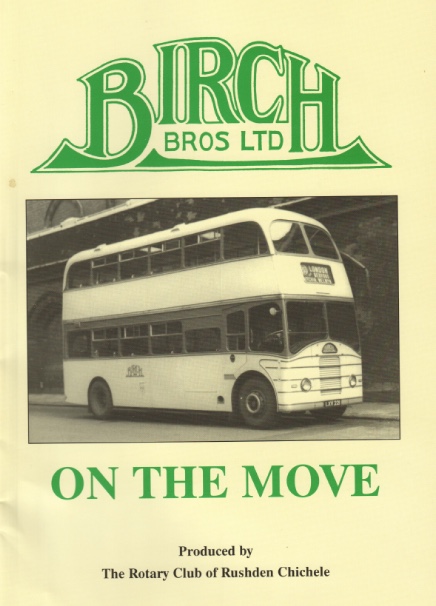
|
|
|
|
An illustrated book 'On The
Move' was published (autumn 2003)
on the history
and the operations of Birch Bros Ltd
by the Rotary
Club of Rushden Chichele.
The iconic Birch coach
station and depot built in 'cinema style' in 1937 in Rushden
(from the rear cover of the book)
|
|
|
|
|
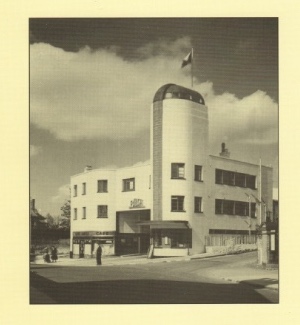
|
|
|
|
|
|
|
|
 |
|
|
|
Published in 2024, A World of Wheels, in which Clive Birch
tells the story of the Birch family and their transport endeavours
across four centuries.
(published by Baron Books of Buckingham)
|
|
|
|
|
|
|
|
|
|
|
|
|
|
An
illustrated article on the tickets of Birch Bros can be found in the
June 2019 issue of the Journal of the Transport Ticket Society
|
|
|
|
|
|
|
|
|
 |
|
 |
|
|
|
|
|
|
|
|
|
|
|
|
|
|
|
|
|
|

